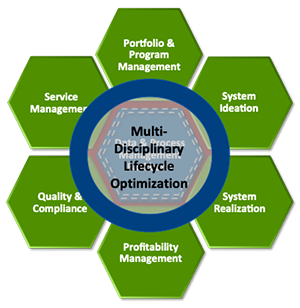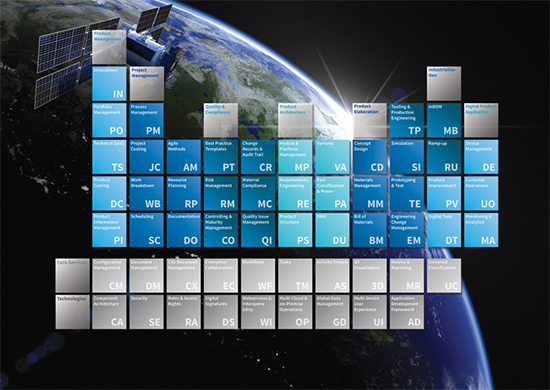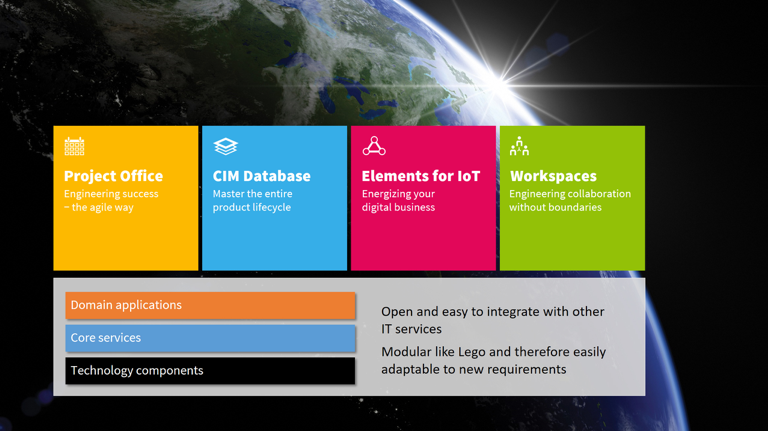Key takeaways:
- Today’s complex, smart, and often highly configurable products require an end-to-end digital product innovation platform that can be extended and scaled as the business evolves.
- CONTACT Elements is a highly modular product innovation platform that supports the design and operation of smart products by enabling the end-to-end digital thread and resulting digital twins.
- CONTACT Elements’ architecture is built on a robust set of open and de facto standards, including REST, Python, SQL, HTML 5, XML, and LDAP.
- CONTACT Software offers a robust set of proven applications that leverage CONTACT Elements, including its PLM-enabling solution (CIM Database), project and extended enterprise collaboration solutions, and an Internet of Things (IoT) solution that supports high value complex in-field assets.
For many years, PLM solutions’ primary function has been to help develop better products, faster and cheaper. While this is still important, it isn’t the only thing that a typical PLM strategy needs to address. Today’s PLM-enabling solutions must support end-to-end lifecycle management of the specification, design, manufacture, and maintenance of smart and connected products. These often complex and highly-configurable products require digital threads and twins, which support a host of digital transformation initiatives that are critical for future business success. This end-to-end lifecycle management necessitates the management of product information from conception through the end of the product’s useful life. PLM-enabling solutions of the past aren’t robust enough to support these requirements in a cost-effective manner. This fact has driven much of the PLM industry to rethink how solutions are architected and delivered to the market; in many ways forcing the platformization of PLM.
The platformization of PLM clarifies the distinctions between strategic and tactical—long- and short-term thinking. At its core, strategic is anything that sustains the extended enterprise and stays ahead of challenges in technology, markets, competition, regulation, etc. In contrast, tactical is concerned with short-term objectives of departments and business units, and is usually focused on tasks and disciplines commonly found within engineering units. Yesterday’s PLM solutions were about the tactical, but tomorrow’s PLM solutions will be those that act as end-to-end lifecycle management platforms that are strategic and sustainable.
CIMdata defines these end-to-end lifecycle management platforms as providing a foundation upon which functional capabilities, data, and processes are enabled and executed—it is everything users need, when they need it, no matter there they are, all in one place. The near-term goal is to enable the innovation essential to create digital products, systems, and services. Users and managers know these platforms must be employed globally, sustaining the enterprise and the environment. The long-term goal of end-to-end lifecycle management is sustainability—that is sustainable innovation. These solutions must be inherently:
- Dynamic, helping companies adapt rapidly and innovate continuously across multiple lifecycles in ever-changing marketplaces.
- Seamless, meaning that all the digital bits and bytes of innovation work together to enable collaboration among users anywhere in the lifecycle across an extended enterprise’s landscape.
First and foremost, PLM platforms enable and enhance the enterprise’s innovation processes. Users get much-needed help to create, manage, share, and reuse product-related information in all its forms and from various sources. Access to these advanced capabilities helps them seize opportunities quickly, as soon as the insights materialize within the lifecycle, and before competitors notice them. In addition, innovation platforms are designed to sustain continuous creativity in products and processes—the breakthroughs, as well as the new-and-improved—across generations of products and product portfolios, and reaching far beyond current offerings.
Finally, these PLM-enabling product innovation platforms must reduce, if not eliminate, dependence on aging applications and fragmented legacy systems. This means users will no longer be constrained by disjointed or out of date workflows that hamstring searches for crucial information. Key information will no longer be inaccessible, for example, and lessons learned will no longer be obscured.
The Product Innovation Platform Defined
According to CIMdata’s definition, an organization’s product innovation platform is a set of evolving functional domains—process, lifecycle stage, and technical domains such as system ideation, profitability management, and quality and compliance (see Figure 1). They are orchestrated by the platform with a “system of systems” approach that, in essence, makes the platform the enabler of the next generation of PLM-enabling solutions.

Figure 1—CIMdata’s Product Innovation Platform
For authors Mark Bonchek and Sangeet Paul Choudary,[1] successful platforms exhibit three success factors:
- Connection: the ease with which others can plug into the platform to share data and accomplish tasks.
- Gravity: how well the platform itself attracts those who need information.
- Flow: how well the platform fosters collaboration and the shared creation of information.
Note the emphasis here on connectivity and collaboration. CIMdata adds the following two more Strategic Imperatives to round-out our product innovation platform definition:
- End-to-End Lifecycle Support: the ability to support the full product/plant lifecycle, from concept through life. Supporting the entire extended enterprise, including all its disciplines.
- Openness: the ability to provide unencumbered access to managed data and related services.
In addition, the Product Innovation Platform is further described by seven strategic characteristics, led by Sustainability. Sustainability means supporting an enterprise’s data- and process-management requirements over an extended period of time—at a reasonable cost while business needs evolve. CIMdata defines three key elements of platform sustainability: Adaptability, Extensibility, and Maintainability. This is what future-proof is all about. Sustainability is, of course, only one key Strategic Characteristic, the other six include:
- Data Management & Find: The ability to manage and find data.
- Through-Life Configuration Management & Traceability: The ability to manage a product’s configuration from concept through its entire lifecycle and provide traceability forward and backwards.
- Process & Knowledge Management: The ability to represent business processes and capture process outputs, as well as capture and organize data representing knowledge.
- Upgradeability: The ability to easily update to a newer version of the solution.
- Enterprise Infrastructure Utilization: The ability to effectively leverage existing and future IT infrastructure to meet a business’s requirements.
- Availability & Stability: The platform’s ability to provide its services when and where needed.
CONTACT Elements, from CONTACT Software, is such a solution—designed to meet these key product innovation platform imperatives and associated characteristics.
CONTACT Elements
CONTACT Elements is at the heart of CONTACT Software’s solution stack. Founded in 1990, CONTACT Software, headquartered in Bremen, Germany, is a pioneer and long-time PLM solution provider focusing on the development and delivery of open PLM-enabling solutions. Like other leading PLM solution providers, CONTACT Software has been developing their platform for many years. CONTACT Elements provides the company and their customers a high level of freedom in managing and evolving their solution. CONTACT Elements makes it possible to administer the platform and the individual applications that run on it independently. This is critical if one wishes to implement a modern Product Innovation Platform. The advantages include:
- Independent and often significantly shorter release cycles for applications
- Customers can easily deploy new functionality as it becomes available in a modular manner
- Capabilities can be rapidly defined or updated, developed, and deployed without updating the underlying platform
- Improved management of individual adaptations or modules
- Rapid and improved scalability
- Lower total cost of ownership
CONTACT Elements is comprised of more than 50 software components all built on top of a robust technology platform that manages the interaction/configuration of the components, their release-capable adaptation to customer-specific requirements, and secure and efficient system operations. The underlying architecture is built on open and de facto standards, including REST-based Web Services application programming interfaces (APIs), Eclipse, PRC/3D-PDF, SQL, HTML, XML, HTTP/HTTPS, LDAP, Transport Layer Security (TLS), and Python—a sound and open development approach. CONTACT Software is a proud contributor to major open initiatives like CODE of PLM OPENNESS, OSLC, Industrial Internet Consortium (IIC), and the Eclipse Foundation. In addition, CONTACT Software claims that using the Python object framework and an extendable data dictionary makes it very easy to extend their platform with new object classes and functionality.
CONTACT Software emphasizes the importance of the overall integrity and user experience of its software stack. Instead of making the portfolio even more complex for customers through heterogeneous acquisitions, new components within the platform appear to be “from a single source.” This was made possible by the synergistic effects of the technology platform and core services (i.e., reuse).
CONTACT Software’s strategy is well aligned with CIMdata’s Product Innovation Platform definition described herein. CONTACT Elements core services applications include document management, workflow, and enterprise collaboration. Other key features that support product- and process-innovation include:
- Standard interfaces to CAx authoring systems such as Dassault Systèmes’ CATIA and SOLIDWORKS; PTC’s Creo; Autodesk’s AutoCAD and Inventor; Siemens PLM Software’s NX and Solid Edge.
- A tight integration with Microsoft Office called OfficeLink, which provides document management and data synchronization capabilities.
- CONTACT’s own fully integrated visualization solution “3D Spatial Connect.”
- Integrations with electronic design automation solutions, such as EPLAN Electric, Mentor Expedition, Altium Designer, and Zuken E³-Series.
- Standard interfaces to leading ERP systems, such as SAP, Infor/Baan, Axapta, Navision, Psipenta, and IFS.
- Enterprise search based on Lucene Core, an Apache open source information retrieval software library.
This comprehensive portfolio of prebuilt standard building-blocks in the platform can be readily configured to support an organization’s end-to-end product lifecycle management application requirements. CONTACT Elements’ building blocks (see Figure 2) are divided into three levels:
- Infrastructure Technologies—this basic level includes database and cloud services for data storage, security mechanisms for controlled access to the system right down to individual objects, interoperability with other enterprise systems such as ERP and authoring systems such as CAD, etc.
- Core Services—these services include the management of documents, workflows and tasks, discussion in activity streams, the universal classification of objects, etc.
- Business Applications—this level is comprised of a comprehensive portfolio of apps that support product management, product architecture, industrialization, scheduling and capacity planning, variants, and requirements management, to name just a few.

Figure 2—The CONTACT Elements Building Block
(Courtesy of CONTACT Software)
It is important to mention that CONTACT Elements can also support the complicated security requirements necessary to control intellectual property in complex global supply chains. Core Services, for example, includes Activity Stream, a social collaboration application that supports discussion threads linked to managed items, all under the security model and access rights governing the development process as defined for each of the applications that leverage the platform. This focus on core services supports CONTACT Software’s philosophy that having good authoring tools is important, but enabling more effective collaboration and integration will speed up the innovation process over the long-term, a crucial element to organizational success.
Finally, CONTACT Software’s complete solution portfolio (see Figure 3) “powered by CONTACT Elements” includes:
- CIM Database for product lifecycle management
- Project Office for the management of engineering projects
- Workspaces for collaboration across company boundaries
- Elements for IoT for services based on digital twin
Elements for IoT is the latest offering from CONTACT Software built on their Elements platform. This solution has been designed to specifically address customers who require IoT capabilities centered on the enablement of the digital twin. This solution’s value is providing data connectivity and management for an organization’s smart, connected products and it can be implemented as a standalone product.

Figure 3—CONTACT Software’s Solution Portfolio
(Courtesy of CONTACT Software)
CONTACT Software’s client list is impressive, with clients who design and produce vehicle components, wind turbines, machine tools; organizations responsible for major projects (e.g., Gotthard Tunnel and Deutsche Bahn ICE Overhaul Program); and companies leveraging their platform to support predictive maintenance of building technology and systems. It is important to note that while they have primarily focused on Europe, their global reach is rapidly expanding.
Conclusion
CONTACT Software’s CONTACT Elements platform is robust and an excellent example of a modern and future proof digital platform. Over the last few years, CONTACT Software has continued to build out and strengthen its platform, as well as building out applications and business solutions that leverage it. The platform’s architecture supports the use of prebuilt standard components for modeling the virtual product, project and process management, and CAx data management. CONTACT Elements’ building block architecture delivers agility and flexibility to maintain and extend a PLM and collaboration infrastructure. CIMdata is impressed with CONTACT Software’s Product Innovation Platform and recommends industrial companies consider it to support their future proof Product Innovation Platform needs.




